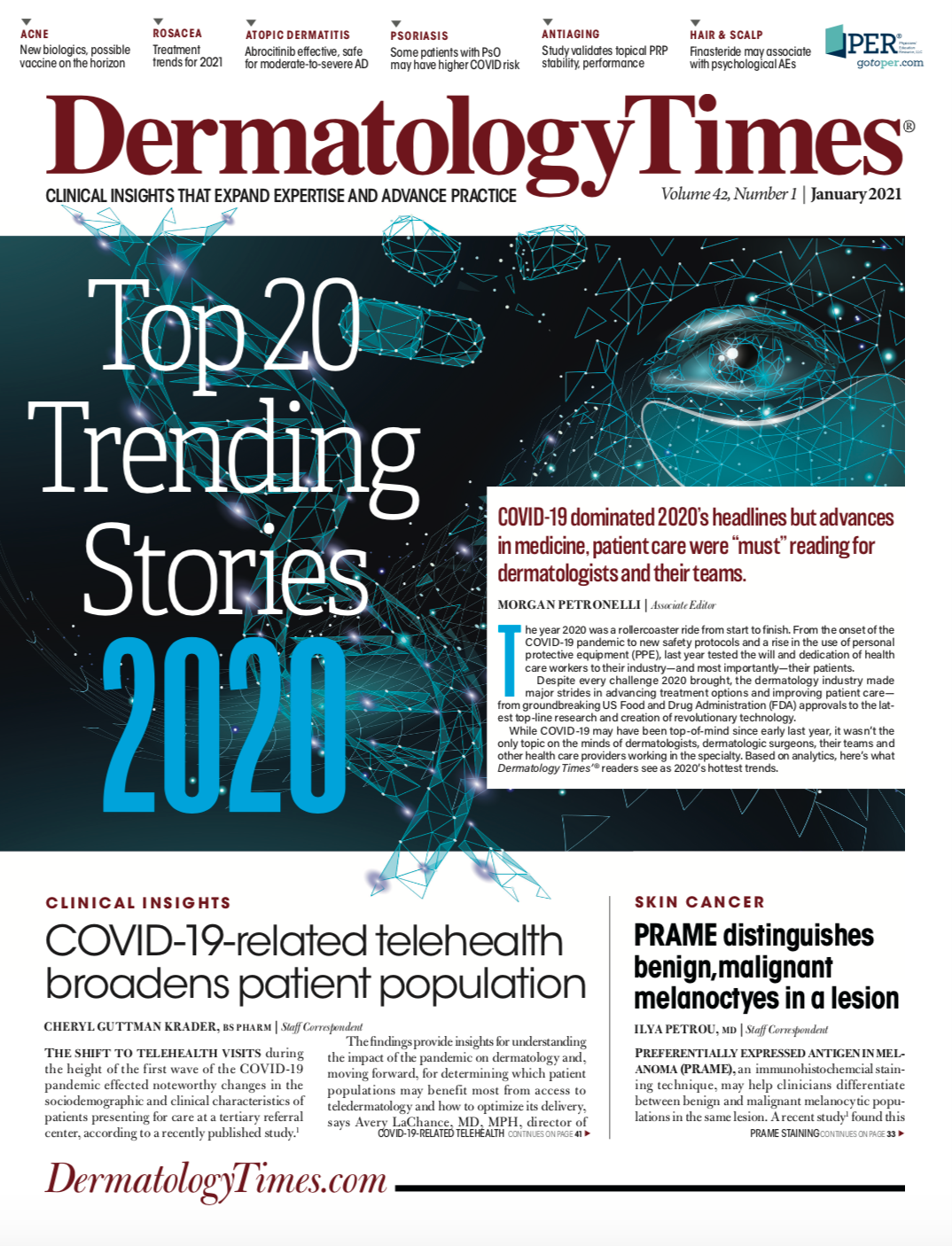- Case-Based Roundtable
- General Dermatology
- Eczema
- Chronic Hand Eczema
- Alopecia
- Aesthetics
- Vitiligo
- COVID-19
- Actinic Keratosis
- Precision Medicine and Biologics
- Rare Disease
- Wound Care
- Rosacea
- Psoriasis
- Psoriatic Arthritis
- Atopic Dermatitis
- Melasma
- NP and PA
- Skin Cancer
- Hidradenitis Suppurativa
- Drug Watch
- Pigmentary Disorders
- Acne
- Pediatric Dermatology
- Practice Management
- Prurigo Nodularis
- Buy-and-Bill
Publication
Article
Dermatology Times
Combination Rosacea Therapy Improves Outcome
Author(s):
Experts are recommending combination therapies as a way to treat rosacea, according to a presentation at ODAC Dermatology, Aesthetic and Surgical Conference 2021 Pre-Conference Sneak Peek Inflammatory Diseases Virtual Symposium.
Combination therapy could emerge as a focus for treating rosacea in 2021. That’s according to Julie C. Harper, MD, who says the use of multiple therapies to address each sign or symptom is “the best and most comprehensive method for bringing relief to patients.”
Harper, clinical associate professor of dermatology at the University of Alabama at Birmingham, Birmingham, Ala., and one of the founding directors and current president, American Acne and Rosacea Society, outlined the benefits of and treatment regimens involving combination therapy in her presentation1 at the ODAC Dermatology, Aesthetic and Surgical Conference 2021 Pre-Conference Sneak Peek Inflammatory Diseases Virtual Symposium in December.1
She discourages treatment solely by categorizing patients with rosacea by type (erythematotelangiectatic, papulopustular, phymatous, and ocular) because symptoms may overlap. Since patients often fit into more than one category, they require more comprehensive methods to effectively treat their symptoms, she adds.
STRATEGIES FOR COMBINATION THERAPY
To optimize combination therapy, Harper says practitioners should subtype patients by lesions and signs of rosacea rather than type. She recommends treating all manifestations of visible symptoms.
“Different lesions and signs of versation will require multiple modes of treatment,” Harper notes
- U.S. Food and Drug Administration (FDA)-approved therapies for treating the inflammatory papules of rosacea, the papules and pustules, including ivermectin (IVM), metronidazole, azelaic acid and sodium sulfacetamide, and sulfur and modified release doxycycline.
- Alpha agonist brimonidine (BR) and oxymetazolinZe, which are indicated for persistent facial erythema or background erythema.
- Device-based treatments such as pulsed dye laser JTP, intense pulsed light (IPL) or electrosurgery.
Harper stresses that the goal is not just partial improvement; it is completely clear skin. Combination therapy treatment can help patients with rosacea achieve that goal faster than single treatments and maximize remission periods while minimizing disease burden for patients, she adds.
Harper highlights evidence-based studies that support combination therapy. The first, a randomized, double-blind, placebo-controlled 2007 study2 conducted over 16 weeks showed inflammatory lesion counts were significantly reduced after 12 weeks with the use of both anti-inflammatory doses of modified release doxycycline and topical 1% metronidazole gel. Some patients receiving the combination therapy reported improvement as early as week 4. This reduction, seen up to week 12, was significant compared to 1% metronidazole gel used with placebo.
In 2017, researchers examined the safety and efficacy of topical IVM 1% cream and BR 0.33% in a multi-center, randomized, vehicle-controlled study.3 Patients had moderate-to-severe rosacea with both persistent diffuse erythema and inflammatory papules and pustules.
“Concomitant administration of IVM cream with BR gel demonstrated good efficacy and safety, endorsing the comprehensive approach to this complex disease. Early introduction of BR, along with a complete daily skin care regimen may accelerate treatment success without impairing tolerability,” study authors concluded.3
However, reduction of papules and pustules and a reduction of erythema is not complete treatment, according to Harper. “Targeting inflammation in the papules and the pustules does not translate to less background erythema." she says. "Combination therapies could target those two things.”
For ocular rosacea, she emphasizes lid care and suggests the standards from the International Workshop on Meibomian Gland Dysfunction (MGD), which recommends warm compresses, lid massage, artificial tears, topical azithromycin, topical emollient lubricant or liposomal spray, and oral doxycycline. The guidelines also include use of topical cyclosporine and topical steroid while monitoring intraocular pressure.
“All inflammation is not the same,” she says. She emphasizes documenting every symptom that is part of the patient's rosacea and treating it with this multi-pronged approach.
Disclosures:
Dr. Harperhas reported disclosures related to Almirall, Cassiopeia, Cutera, EPI, Galderma, and L’Oreal.
References:
1. Harper JC. Treating rosacea in 2021. Presented at: 2021 ODAC Pre-Conference Sneak Peek Inflammatory Diseases Virtual Symposium; December 3, 2020.
2. Fowler JF. Combined effect of anti-inflammatory dose doxycycline (40-mg doxycycline, usp monohydrate controlled-release capsules) and metronidazole topical gel 1% in the treatment of rosacea. J Drugs Dermatol. 2007;6(6):641-645.
3. Gold LS, Papp K, Lynde C, et al. Treatment of rosacea with concomitant use of topical ivermectin 1% cream and brimonidine 0.33% gel: a randomized, vehicle-controlled study. J Drugs Dermatol. 2017;16(9):909-916.







